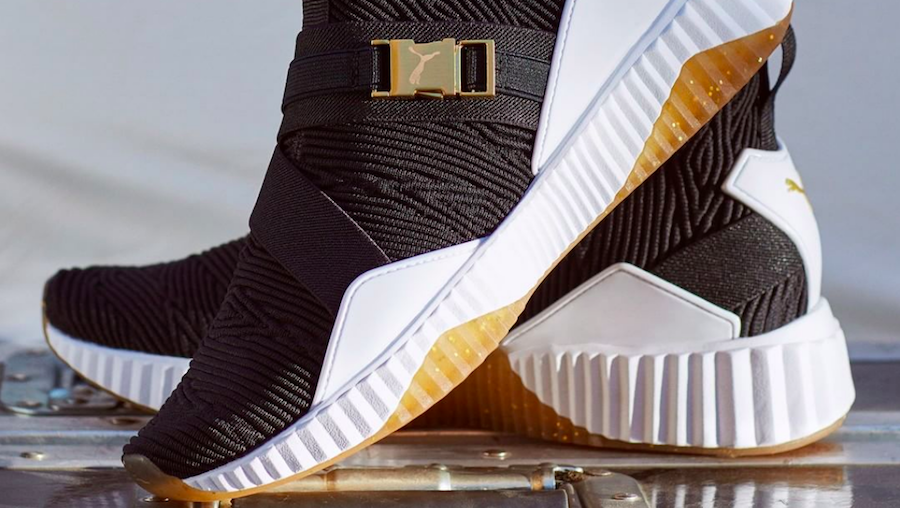Puma SE said it scrambled to catch up to a fashion shift toward bulkier footwear to enable it to continue its robust top-line momentum. But due to higher marketing expenses to maintain that growth, Puma wasn’t able to lift its profit outlook for the year.
“It’s been a tough quarter to try to react to it as we had to accelerate our sourcing very quickly … I would have wished we were faster,” Bjørn Gulden, CEO of Puma SE., admitted on a conference call with reporters.
But with items such as the chunky Thunder seeing some quick sell-outs, Puma’s top-line growth momentum continued and Puma raised its forecast for currency-neutral sales this year by 2 percentage points to between 12 percent and 14 percent. Puma kept its profit guidance due to additional investments in marketing that will be required to hit profit guidance.
Those investments include marketing costs taken to relaunch performance basketball products for the first time in 20 years. Basketball footwear is due to hit stores in late September or early October.
Companywide, currency-neutral sales grew 15.0 percent in the second quarter, slowing from a 21.5 percent gain in the first quarter. Double-digit growth was seen in all regions and product segments. Weighed down to currency headwinds, net sales grew 8.3 percent to €1.05 billion.
By region, the Americas led the growth, up 18.7 percent on a currency-neutral basis and accelerating from the 15.6 percent increase seen in the first quarter. Reported sales in the Americas increased 6.4 percent to €377.3 million.
In other regions, sales in the EMEA region grew 10.5 percent on a currency-neutral basis and 8.0 percent on a reported basis to €416.0 million. Asia/Pacific sales were up 17.3 percent on a currency-neutral basis and 11.8 percent on a reported basis to €255.9 million.
By product category, footwear led the way, expanding 18.4 percent currency-neutral (10.4 percent reported) to €511.1 million. Apparel grew 10.5 percent currency-neutral (10.4 percent reported) to €463.0 million. Accessories sales were up 15.0 percent currency-neutral (10.3 percent reported) to €188.4 million.
Puma’s earnings rose 37.8 percent in the quarter to €57.6 million on improving gross margins and continued sales momentum.
Gross margins improved 210 basis points to 48.6 percent, mainly related to more sales of new products with a higher margin, further sourcing improvements and positive currency effects.
Operating expenses (OPEX) rose 11.1 percent to €456.3 million and increased as a percent of sales to 43.5 percent from 42.4 percent. The increase was due to further marketing activities and higher sales related variable costs based on increased sales volumes and higher retail investments related to the increase of Puma’s net store count. Operating earnings climbed 32.7 percent from €43.4 million.
“The second quarter developed positively for us with sales growing organically 15 percent and EBIT increasing 33 percent,” said Gulden. “All regions and all product divisions posted double digit organic growth. The continued strength of the Euro gave us headwind in reported sales but, along with other currency effects, this also impacted our gross margin positively.”
He noted that the first half of the year saw “major shifts in product trends and consumer demand, especially for footwear. But we feel that our ‘fast attitude’ and quick reaction time allowed us to continue our growth.”
On the call with reporters, Gulden said Puma had to bring forward plans for the chunk Thunder model due to demand from retailers as the fashion industry responded to the “ugly” trend for baggy clothing and 1990s sneakers. He noted that the recently-launched Thunder “won the hearts of the fashion-forward crowd with its disruptive design and its bulky, unapologetic look. The first two product drops sold out within hours.”
In Running and Track & Field, the 19-year-old Cuban star, Juan Miguel Echevarria, took the first place at the Stockholm Diamond League Meeting with a long jump of 8.83m, which was chosen as the “2018 Season Highlight” by the IAAF. At the GULDENI Commonwealth Games, Puma athletes won eleven medals. Olympic and World Championship silver medalist Will Claye won the men’s Triple Jump by setting a new world-leading mark with 17.43m at the World Indoor Championships in Birmingham.
Earlier this year, Puma enlarged the company’s portfolio of federations by signing a long-term partnership with the Norwegian Athletic Federation. French sprinter and European record holder in 100m Jimmy Vicaut and Italian high jumper Gianmarco Tamberi also signed on as ambassadors.
In Motorsport, the company’s three partnered F1 Teams, Mercedes Amg Petronas, Scuderia Ferrari and Red Bull Racing, continue to lead Formula One rankings.
Operationally, Gulden said Puma’s strategy continued to focus on five priorities: increasing brand heat, offering a competitive product range, proposing a leading offer for women, improving the quality of distribution and strengthening its organizational infrastructure.
“We feel that Puma is on the right track as our strategy, marketing and products are starting to show results,” said Gulden. “This has been once again confirmed by improved financial results, increased sell-through performance and the continued positive feedback from our retail partners.”
Regarding increasing brand heat, Gulden said finding the right influencers and letting them communicate on behalf of the brand has become an essential part of Puma’s strategy. Said Gulden, “We have contracted new athletes, cultural icons and influencers who have helped to further fuel Puma’s brand heat, such as Selena Gomez, the most followed person on Instagram. Selena has been working alongside Puma’s design team to create exciting products for our female consumers.”
Puma’s women’s category continued its successful “Do You” campaign with ambassadors including Cara Delevingne and the dancers of the New York City Ballet. Key styles behind the women’s footwear business were the training shoes Phenom, Muse and Muse Echo, while the newly launched DEFY showed “promising” initial results.
In men’s training, four-time Formula One World Champion Lewis Hamilton is backing the “24/7” training proposition that calls for gear that work in the gym and the street. As part of this collection, Puma just launched the training shoe Mantra Fusefit.
Gulden said quality of distribution remains a focus for Puma with a focus on providing a strong contribution to retailers. Said Gulden, “We work hard every day to ensure that our contribution to their business is positive and further improving. Feedback from our retail partners continues to be good. Retailers in most channels have started to dedicate more shelf space to Puma, allowing for our business to be based on a broader selection of styles.”
Finally, Puma has continued to improve its organizational structure and infrastructure. This includes the completion of the extension of the its headquarters building in Herzogenaurach that now packs more than 1,000 employees together under one roof in a state-of-the-art facility. Said Gulden, “This not only allows for faster communication and better alignment but also adds to our great team spirit.”
Looking ahead, Puma maintained its guidance for the full year. Operating earnings are expected to come in between €310 million and €330 million. Puma now expects sales to rise between 12 percent and 14 percent, up from previous guidance of a gain between 10 percent and 12 percent). The company expects gross profit margin improvement of approximately 100 basis points and a high single-digit rate increase in OPEX related to additional investments in sports marketing and higher sales related variable costs. Management still expects that net earnings will improve significantly in 2018.
Said Gulden, “Despite the changes in product trends and the uncertain business environment caused by volatile currency rates and difficult global trade environment, we feel confident that we will reach our full-year EBIT target between €310 million and €330 million, which is a growth of around 30 percent.”
Photo courtesy Puma
















